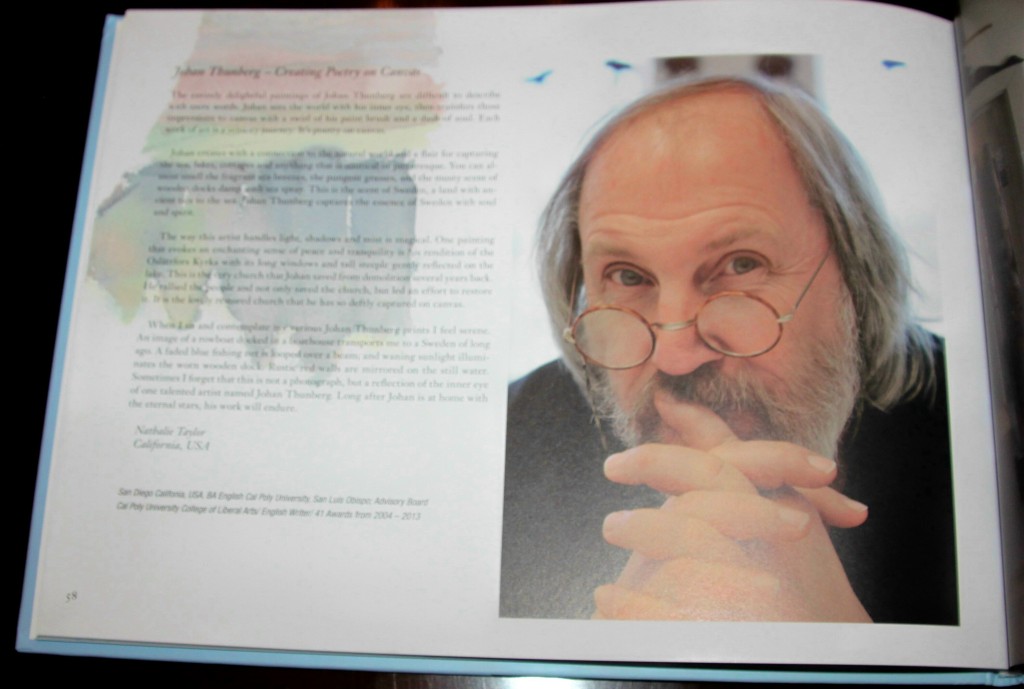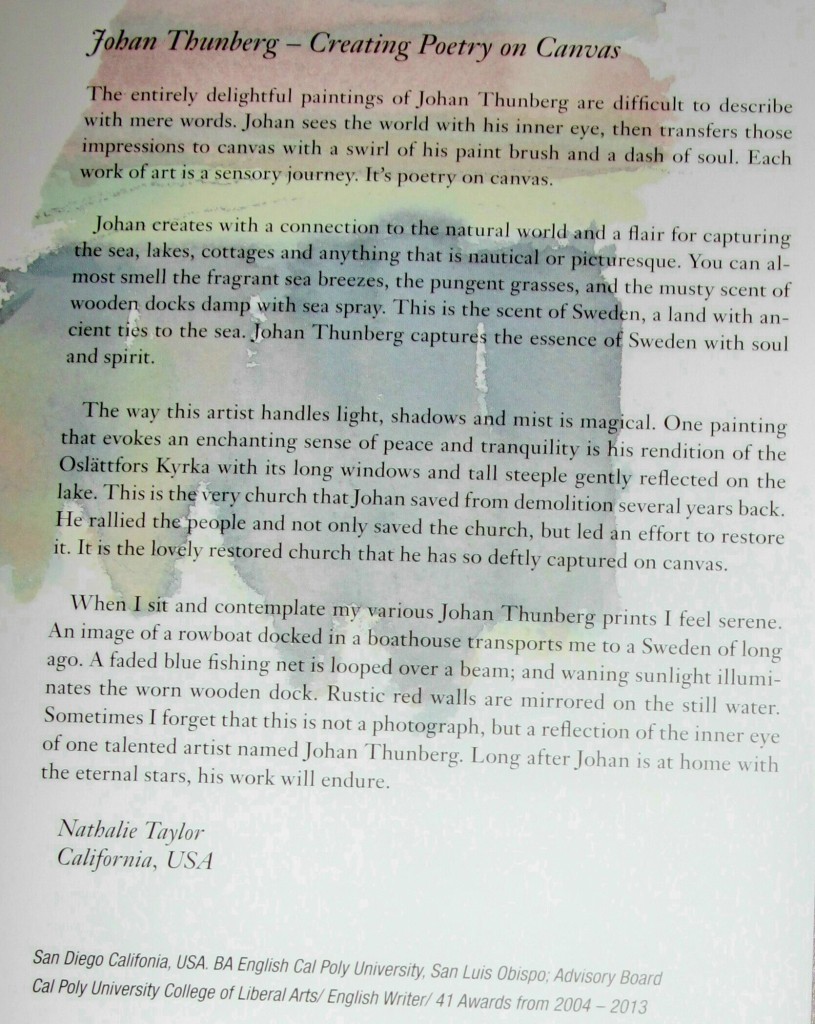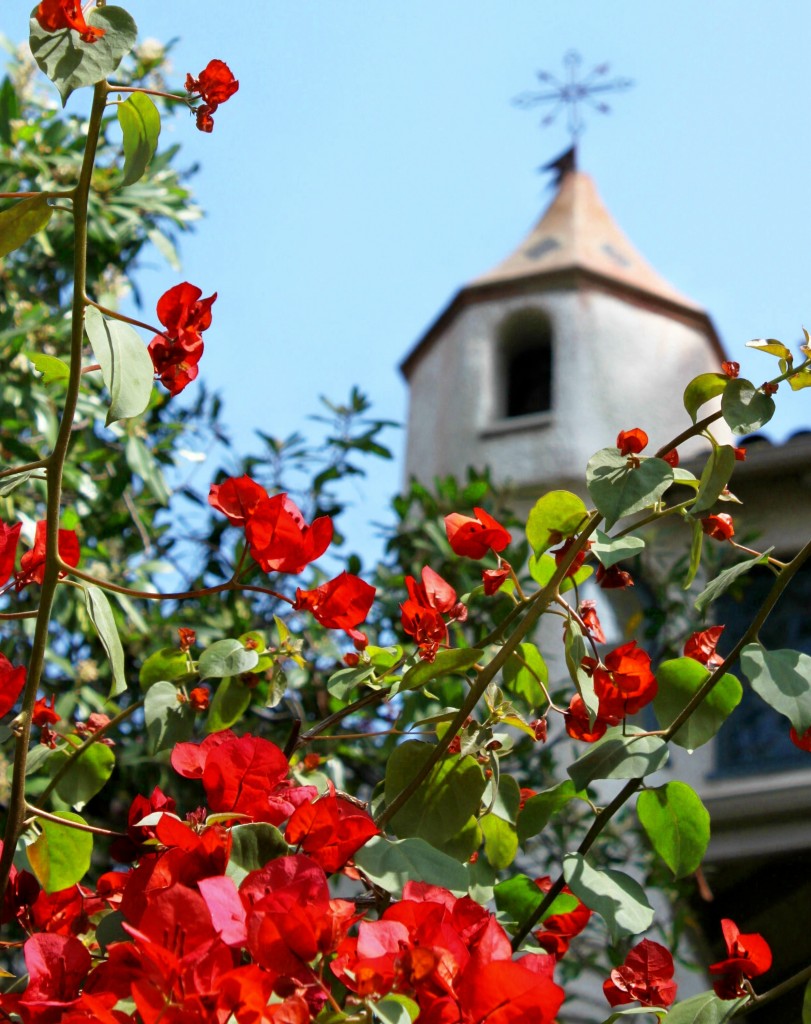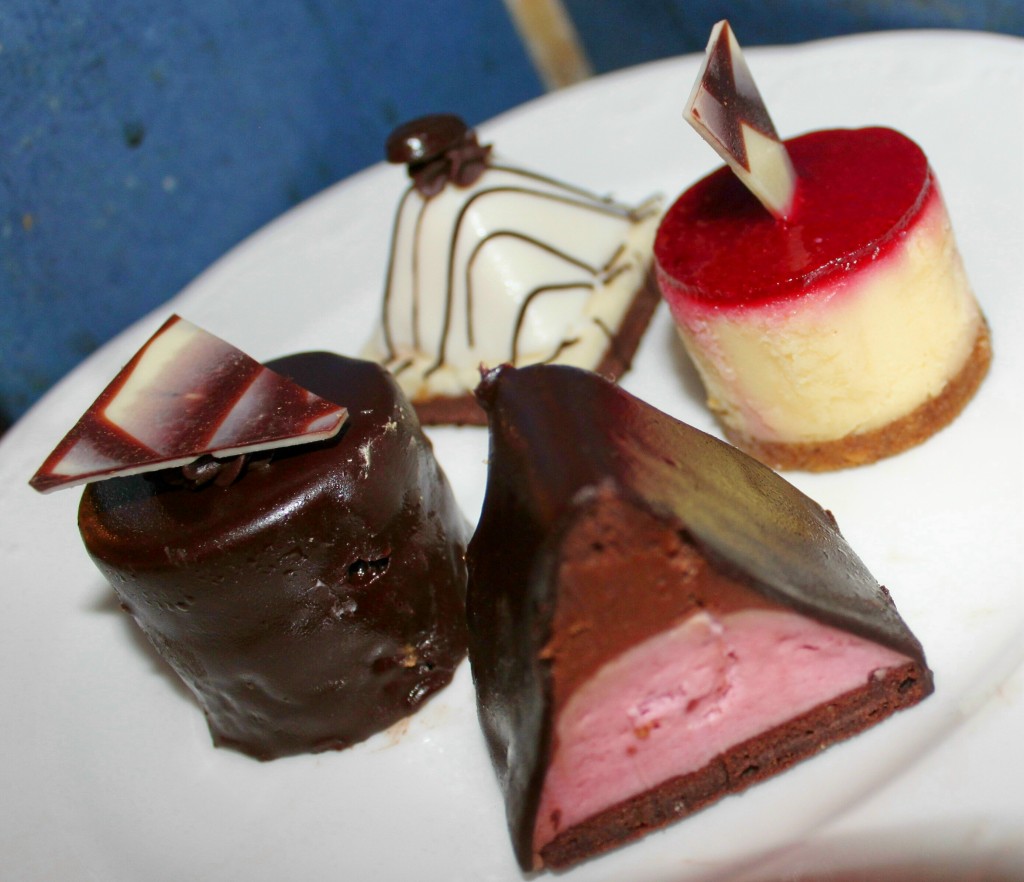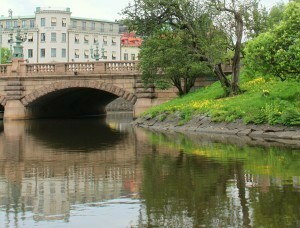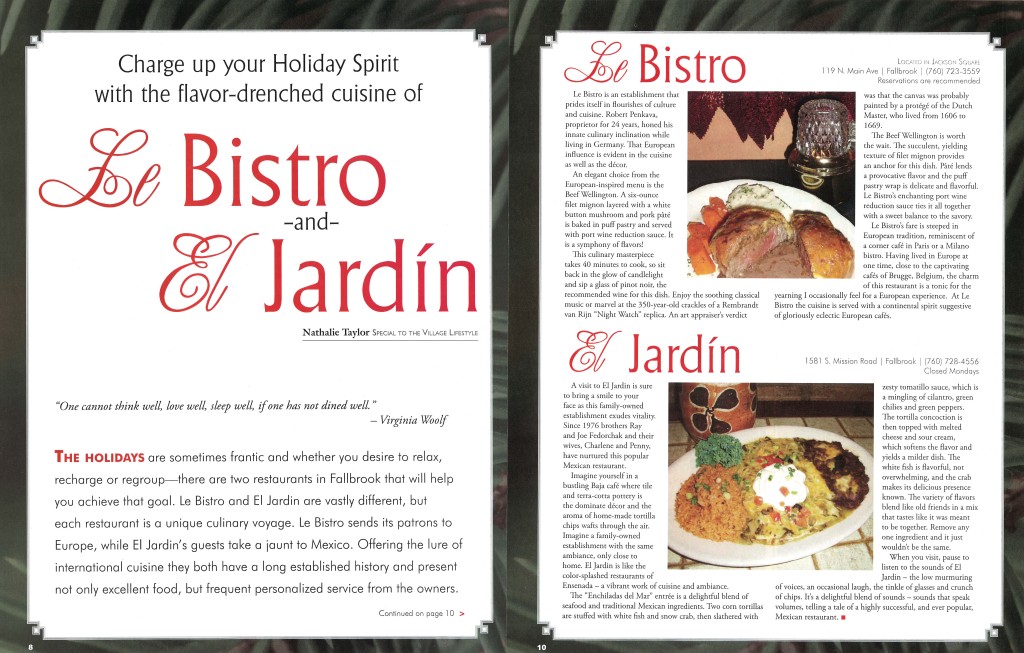Escape to the Inspiring and Captivating Mission Inn!
Imagine sitting in a 100-year-old patio courtyard surrounded by vibrant red bougainvillea twining and twirling around static iron balconies. You look up and see a Della Robbia-style Madonna and Child plaque on a high Moorish-type wall with a thousand intricate curves. Red Spanish tile walkways show slight dips from a hundred years of footfall. Twittering birds flit to a fountain trickling small streams of water to separate basins. Does this sound like a peaceful, somewhat exotic destination? Does it make you want to reach for your passport and be whisked off to Spain or Morocco?
Even though this courtyard with its terra-cotta tones resembles a captivating destination like Spain, it is right here in Southern California – Riverside to be exact. For me it is reminiscent of a trip to Spain. Others might be taken back to a time in Morocco or Italy – but most will probably just revel in the immediate beauty of this historic hotel called the Mission Inn.
One of the joys of traveling is to be transported to a world that is inspiring and beautiful…and will serve to awaken the senses. A visit to the Mission Inn will do just that.
The Mission Inn is close enough for lunch, and distant enough for an overnight stay. Built in “Mission Revival” style, the hotel has had various construction phases, but the first wing was completed by Frank Miller in 1903, over a 100 years ago.
This architectural showpiece is furnished with priceless treasures and unique objects that Miller collected during his world travels. He amassed a staggering amount of bells, 400 of which can be found on the grounds of the inn. Tiffany stained glass windows, Chinese vases and various architectural accoutrements unite in a delightful array of the eclectic – like a small-scale Hearst Castle.
Guests are free to wander most of the property and discover a myriad of architectural wonders – a Spanish-style chapel, fountains, reflecting pools, intricately fashioned doors and colorful tiled roofs. Like the Hearst Castle, there is something fascinating around every corner.
Dining at the Spanish Patio restaurant is a delightful and satisfying experience. Beauty is everywhere, and it’s almost enough to distract you from your fantastic feast – almost. The lunch buffet is inviting with a counter laden with such delicacies as fresh salmon, flat iron steak and a marvelously crisp cheddar lavosh. The savory choices vary daily, but the dessert table remains fairly constant. That is where guests find a stunning array of petit fours and tea cakes – with chocolate or without – but always fresh.
In the guest rooms differences abound. This is not a uniform hotel – it is marvelously eclectic. Our suite was comfortable and sparkling clean. A balcony afforded a view of the pool, and at night we could look down on a vine-covered arch with bells in lighted niches. The bells rang melodically and were not at all intrusive.
A visit to the Mission Inn will awaken your senses to appreciate this oasis in the midst of a bustling world – this place where art, architecture, fine food and delicious scents intermingle beautifully.
Continue Reading
The Cusp of Summer ~ A Scandinavian Sojourn
Göteborg Canal FALLBROOK VILLAGE NEWS Thursday, August 29th, 2013 Issue 35, Volume 17. Barken Viking, Göteborg NATHALIE TAYLOR Special to the Village News Lagom. According to my cousin Håkan there is no English equivalent for this Swedish word. Dictionaries attempt to translate, but fall short. The word, as he […]
Continue ReadingAfternoon Tea – England’s Noble Tradition
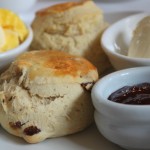
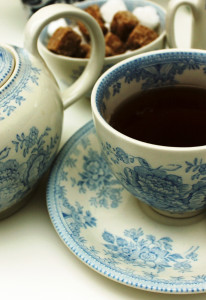 FALLBROOK VILLAGE NEWS
FALLBROOK VILLAGE NEWS
Issue 31, Volume 17.
Nathalie Taylor
Special to the Village News
“There are few hours in life more agreeable than the hour dedicated to the ceremony known as afternoon tea.” ― Henry James
Taking tea is a subdued tradition – a gentle treat. “Tea” – the word itself is a graceful, almost non-word, the pronunciation is so brief.
The allure of formal tea enticed me when I was about twelve. That is when I first took tea with the women of my family in Buffums’, an elegant department store in Long Beach. I remember the petit fours – perfectly crafted cakes that looked like doll cakes. They were only an inch or so high, but four layers thick, with icing between spongy layer after spongy layer.
Since that first experience I have enjoyed tea in some captivating settings – from the tame and proper Harrod’s in London where scents of frosted cakes and smoked salmon sandwiches swirl about exquisite tables – to a crowded room above a bustling rug and copperware bazaar in Kusadasi, Turkey, where the air was tinged with a swirl of dust, tobacco, fruit and the pungent scent of dyed fabric baking in the hot sun.
At Harrod’s the tea I chose was a robust, but conventional, English Breakfast tea served in a pristine white bone china cup. In Kusadasi I timidly sipped an unnamed, but aromatic tea from a tall thin glass with a base of dented metal.
I have come to realize that the ceremony of “Afternoon Tea” can be varied with the country and region, but the one constant is that aromatic beverage coaxed from leaves that bear the name, “tea.”
Most tea rooms in England offer a selection of up to ten different blends of tea, and I have sampled many, but always return to English Breakfast tea. This rich and bold flavored tea is a blend of various black teas. Add a bit of milk to the steamy potion and you have a perfect cup of tea.
The Orangery at London’s Kensington Palace was built in 1704 for Queen Anne and was the scene of many a court affair. In 1988, when I first pressed my nose to one of the tall Orangery windows, the building was empty and desolate, with a vague aura of past glory. The sun was still streaming through the window making patterns on the drab cement. I wanted to sit in one of the sun patterns and sip a cup of tea.
Years later, when I returned to the palace with my niece, Shannon, I was confident that my musings must have passed through the air waves – the Orangery, once again, was filled with the soft murmur of voices. It had become a graceful tearoom with white columns and a cheery interior.
On a recent trip to London with my mother, Barbara, we enjoyed an elegant Afternoon Tea at the Orangery where subdued light softly illuminated the perfectly sliced tea sandwiches; and the scent of fragrant, exotic teas transported us to another era. My “Mum,” as I affectionately call her when we are in England, is of English and Scottish descent, so teatime is naturally a lure, as well as a delight, for her.
In the Orangery, a hushed atmosphere pervaded despite the many guests. We sipped tea from dainty gold-rimmed bone china cups and relished the soft orange and currant scones spread with clouds of Cornish clotted cream. A delicate chocolate truffle cake with crème fraiche was a fitting finale.
At the British Museum in London, Mum and I discovered the Court Restaurant situated under an impressive curved steel and glass roof. The museum’s Afternoon Tea had more of an international flair and offered “savoury” selections. I chose a marinated bavette steak. This cut of beef possessed intense flavor, but a tender texture.
At the Court Restaurant the trappings of teatime – tea cups, saucers and tea pots, are vintage and lend a charming air to the experience. Silverware with Bakelite handles, as well as rough linen napkins in hand-dyed colors, are of another era.
In southwest England lies the city of Bath. The Grand Pump Room was christened by the Duchess of York in 1795, which doesn’t seem so long ago when compared to the 2,000-year-old Roman baths that bubble nearby. The room was mentioned in the Jane Austen novel, “Northhanger Abbey” and still possesses a stately mystique.
Searcy’s restaurant at the Grand Pump Room offers an elegant array of delicacies for Afternoon Tea. Mum and I enjoyed our meal in the Georgian-style hall under a massive crystal chandelier worthy of a palace. Plush, red curtains were draped across the tall leaded glass windows framed by white Corinthian columns. The ceiling was so high that voices got lost.
A three-tiered porcelain tea tray held fresh currant scones, sandwiches and assorted pastries. True to tradition, crusts were not allowed on the tea sandwiches, which included egg and cress, as well as smoked salmon and thinly sliced cucumber.
Mum and I savored every bite, every view, and every sip of that quintessential English beverage called “tea.” We lingered long after the last pastry was gone – imagining Jane Austen, with a swish of her taffeta dress, gracefully twirling under the glittering chandelier.
Continue Reading


